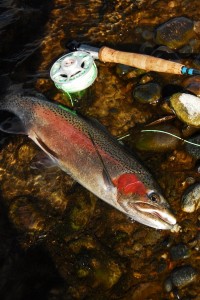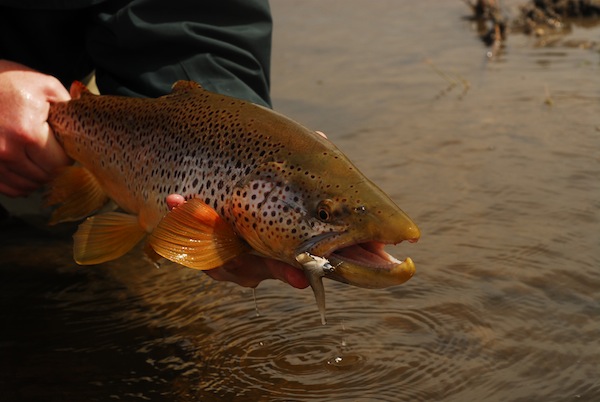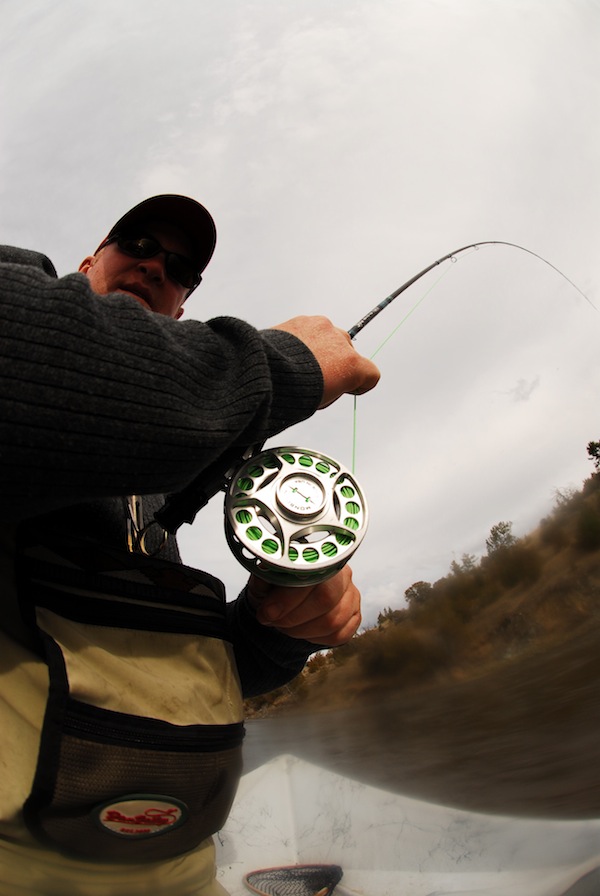 I penned this story a year or more ago and it ran in the pages of Fly Rod & Reel. I think it’s worth reprinting here because when I read it I get fired up and want to throw a line. And this would not be a bad time to do so; the Bighorn, Missouri, Ruby, Yellowstone and Madison rivers, among many others in the West, are prime right now for throwing streamers. It may be cold out there, but fish still eat. Hopefully, this piece gets you out there, this coming spring or sooner.
I penned this story a year or more ago and it ran in the pages of Fly Rod & Reel. I think it’s worth reprinting here because when I read it I get fired up and want to throw a line. And this would not be a bad time to do so; the Bighorn, Missouri, Ruby, Yellowstone and Madison rivers, among many others in the West, are prime right now for throwing streamers. It may be cold out there, but fish still eat. Hopefully, this piece gets you out there, this coming spring or sooner.
I LIKE CATCHING AS MANY FISH as possible and I’m prone to keeping at least loose track of numbers if only to gauge, in a vaguely scientific way, one day or one season versus another.
Some say that scorecard mentality is all about vanity and ego, but I’ll take quality over quantity every time because dealing in sheer numbers, in fishing and life, is setup for failure.
I guess that’s why I like difficult but not impossible fish, such as steelhead and tarpon, and why I would become obsessed with permit if I decided to pursue them with regularity. I also like to twist the odds when trout fishing, choosing most often—at least on the big, broad streams—to throw articulated streamers, specifically trying to draw mature, fish-eating trout from their cut-bank lairs or the bottom of deep pools. It’s not easy fishing or a numbers game, just good fun with the possibility of high reward.
If you fish streamers, southwest Montana is one of the best places in the West to do just that. A host of rivers, including the Yellowstone, Jefferson, Madison, Beaverhead and Big Hole—even the Ruby—provide legitimate shots at trout that stretch toward six or seven pounds and some that may reach 10 pounds or more. You know, those fish that everybody else catches.
Former Montana Fish, Wildlife and Parks biologist Dick Oswald says there are plenty of bruisers in the Big Hole, Beaverhead and Jefferson that anglers never see. Oswald isn’t lying; just a couple years ago FWP shocked a 34-inch long, 16-pound brown from the Big Hole—and that is only the Big Hole’s fourth largest fish on record. Other notables include a 30-inch, 20-pound rainbow that Oswald saw each year. And fellow biologist Ron Spoon shocked a 14-pound brown in successive years from the Jefferson River, under a bridge in a pile of woody debris and scrap metal.
“I think all the really big trout in southwest Montana are freaks,” Oswald said during an interview prior to his retirement. “It takes a bizarre combination to grow a fish like that. Every one that we see is a sterile female with a strange, long-lived component thrown in. And they have a unique behavioral trait, too. They don’t get that size eating mayflies. They can’t afford to rise. They are fish eating machines and I figure their largest food component is juvenile whitefish. Second would be burbot.
“We always find those trout in the deeper pools,” Oswald added. “But to merely go to those environments and hope to catch one isn’t a sure bet. A guy could spend a lot of fruitless hours casting small flies to fish that aren’t even there. A guy could increase his odds by using something far and away bigger than a standard fly. If I had any interest in catching one of these fish I would go there with my pike flies.”
Among southwest Montana rivers the Big Hole is my favorite and I try to fish as many sections as I can during spring. I’m always tempted to spend all of my time on the canyon water, but my favorite float is on the upper river, in a mostly flat-surfaced spring creek-like section that twists from Wisdom downstream to Wise River. That reach offers shots at browns and rainbows that range from three-to five pounds, and a few larger than that.
I fished that stretch last May with Dan Summerfield. He’s an anal-retentive engineer from Missoula. He’s the kind of guy who when not catching fish will sit on a boulder and inspect his gear and stare at the stream for answers, as if studying a blueprint with a faulty angle that causes a storm-drain to flood some residential neighborhood. There’s an answer out there that science can unlock, he’s sure, and if he stares long enough surely he’ll figure it out.
I’m the kind of guy who might sit on that rock in a Buddhist posture if I were to sit on a rock at all. But instead, I don’t stop throwing and rarely take time to really inspect my surroundings. I figure if I keep my fly in the water, no matter what I’m casting, and throw in the right place to the right fish, it will eat. When it comes down to it Dan and I usually catch an equal number of trout, but on opposite days—sometimes he whacks them and I can’t buy a fish. Other times it’s the reverse. If either of us could break through our ingrained method and draw from the other we’d really be onto something. But we’re still young enough to be competitive so when I catch a good fish on something Dan would never throw or from a place he wouldn’t cast, instead of offering props he says something like, “Gawd, that was a stupid fish.”
I’ve fished the upper Big Hole in all sorts of inclement spring weather and water conditions and always pulled a hog or two out during the standard eight-mile float. On the day I fished with Dan we found the fishing to be extremely difficult even though each of us stuck decent fish right out of the gate. Our hopes died over the next four miles when we didn’t even get a grab. Dan was headed for a “thinking rock” when clouds built behind us and I said, “Come on Aristotle, we’ve got to get moving because that looks serious.” A few minutes later the rain hit hard and thunder roared at our heals. I saw a few lightening flashes, but nothing close so we kept casting, this time with Yellow Yummies.
The Yellow Yummy, for whatever reason, is a pattern that the Big Hole’s rainbows and browns love. I often wonder, does a Yellow Yummy represent a juvenile brown trout or a young burbot, which are a codfish native to the upper Missouri drainage, including southwest Montana? Burbot spawn under ice during winter and the young emerge in April. By the end of the their first year they may be four inches long and by age two they could be eight inches long. In either case, that’s a good meal for a trout, especially a mature fish in the four-to 10-pound range. A young burbot carries a darkish brown and olive back, dark pectoral fins, a white belly and sides that are a mix of mottled brown and pale yellow.
Adequate burbot imitation or not, the Yellow Yummy clicked that day and by the end of the float we had two 20-inchers to our credit and a couple larger fish (always larger, right?) that we missed. During a spring day on the Big Hole, or even the Jefferson, that’s about what you should expect; enough fish to keep you engaged; a few in the net; and the big one that got away—incentive to brave the elements and return the next day to see if you can find that fish you missed.
This streamer fishing isn’t for everyone because spring in the Rockies, or anywhere else for that matter, brings weather and water conditions that turn on a dime. Any serious angling effort might die before it ever begins, when the water blows out or six inches of the white stuff lands on your hat brim and all you’re wearing is some khaki, paper-thin safari suit that screams zebra-hunt instead of trout-foray and should only be donned during a mid-summer heatwave. Believe me, if you fish trout in the spring, you won’t need to zip off half your pants.
What you do need are those streamers and this, too, might feel like a dagger to the heart for those who only fish traditional dry flies, hatch-matching aficionados who garner my respect until they shout all sorts of madness, one example being, “Well, I’d rather take a 10-inch trutta on a size 20 Trico than anything under the surface.” And to that I often respond, “I like fishing dry flies, too. But, come on, get your nose out of the air. Who cares how you catch a fish as long as it’s taken legally and released alive?” Besides, casting those mega-flies for giant trout is as close as you’ll get to the thrill of playing Mortal Combat or Call of Duty Black Ops without thumbing a joystick. Another attraction is fishing streamers from a driftboat, where an elevated stance allows anglers to track the progress of their flies and whatever decides to chase those patterns, sometimes all the way to the chine. This type of fishing is as visual, or even more so, than drifting dry flies during the heat of summer hatches. A final shout out for streamers: many tiers are using progressive materials to create brand-new patterns that take the lead from conventional tackle and mimic the exact movements of baitfish. These new flies are appealing to me because I like to tie and fish revolutionary patterns that make me think, Maybe this is the fly that dupes them all. Woolly Buggers? Zonkers? Tied on standard long-shank hooks? So passe.
One recent innovation is Galloup’s Sex Dungeon and I’ve fished that pattern with great results on the Bighorn and the Smith rivers, times when something happened that I can’t explain and the fishing went from one trout every mile or so to a fish either attempting to eat or successfully eating on every few casts. When that situation occurs, which is rare, and the bang-the-banks streamer show is on, there’s no more exciting way to throw.
I also fished that fly last spring on the Jefferson with local guide Frank Kneeshaw, who typically goes by Frank-The-Tank or Frankenstein, and drives a beat old white Ford Explorer with more than 200,000 miles on it and about 200 flies stuck in its dashboard. The thing smells like a tobacco plantation and wouldn’t resell if the price on it was a tax credit. When this rig dies, it’s dead for good and probably joins ranks at a junkyard where it may rust into oblivion carrying a lot of serious trout bum stories that may never make it into print. If you ask me, that Explorer belongs in the Freshwater Fishing Hall of Fame.
Our day on the Jefferson, shared with mutual friend Jon Yousko, a top rep for Simms, turned out to be another typical streamer day with a few nice browns to the net, but nothing over 18 or 19 inches. When the time was right I placed lead on the leader and dredged the holes with that Sex Dungeon. Other times I fished it unweighted and watched a couple browns flash underneath, pissed-off for sure, but not quite convinced they should take a whack at the thing. Along the way we passed a few pods of rising trout, solid 12-to 16-inch fish, but not the meaty five-pounders we hoped to hook. So we kept the dry-fly rods in the quiver, just like the biologist, Oswald, told us to.
A couple days later, Kneeshaw and I were on the Big Hole with Summerfield, enduring seven hours of straight rain and sleet. Because of that, the river was higher and more off-color than we like (flooding actually) and all the fish were tucked in where they could find shelter, less interested in eating than avoiding a flush to the Gulf of Mexico. Somewhere along the way Dan threw his arms in the air, as if to solicit divine intervention. When he directed Kneeshaw to pull the boat to the bank we knew he’d lost faith and was looking for a rock.
“Get a beer,” Kneeshaw demanded. “It’s the water. We’re fishing in a flood!”
An hour later, while Kneeshaw backed that Explorer and a boat trailer through a foot of water that flooded a grassy field, Summerfield was still silent, thinking hard.
“Tomorrow, the upper Big Hole and Moscow Mules at the Wise River Club,” I said.
That snapped him out of a daze and I saw the wheels turn; Summerfield remembered the last time we fished that stretch, when we each caught a couple good fish, and that provided hope. And hope, during spring, when passing on dry-fly possibility and, instead, throwing streamers for oversized trout, is what you really need.


